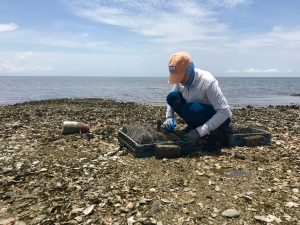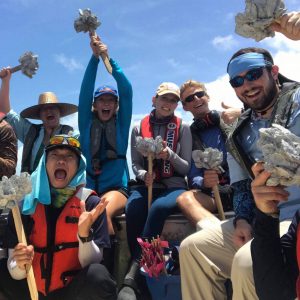By Katrina Rossos
Samantha Hoskins, a senior studying wildlife ecology and conservation, worked as an intern at the Nature Coast Biological Station. Originally from Fernandina Beach, Florida, she learned about the summer internship program through a post on Instagram.
“I was already familiar with the Cedar Key and Nature Coast region after volunteering for cottonmouth research with Mark Sandfoss on Seahorse Key,” Hoskins explained. “I learned about this work by asking about volunteer opportunities during Dr. Harvey B. Lillywhite’s Biology of Snakes course.”
As an intern, Hoskins assisted the graduate students and research coordinator in Peter Frederick’s Lab. The Frederick Lab characterizes oyster populations and oyster reef ecosystems within the Nature Coast, Big Bend, and Apalachicola regions of Florida. They are currently working on the Lone Cabbage Oyster Reef Restoration Project where the lab has installed limestone boulders meant to aid in reinstating the oyster bar.

Hoskins spent most days on a boat, standing in water, or out on the oyster bar. When positioning concrete oyster clusters, she had to set stakes and clear the oyster bar. Hoskins also took notes, collected water samples, monitored salinity readings, culled wild oysters, cleaned oysters, and helped the team with tagging.
Hoskins also conducted water quality monitoring for Lakewatch, a citizen science project. In addition, she assisted with another citizen science project that involved wild bay scallop distribution in the Apalachicola, Panama City, and Port St. Joe areas of Florida. This project was conducted in partnership with the Nature Coast Biological Station and Florida Sea Grant, according to Hoskins. “The purpose of this project is to increase public interest in scalloping, increase depleted scallop populations in St. Andrews and St. Joseph Bay, and reintroduce scallops in other suitable areas from which scallops have disappeared,” she explained.
When working with the Scallop Sitter program, Hoskins gained outreach experience by helping conduct two public workshops. She also constructed scallop cages and counted and distributed wild scallops.
“We were primarily concerned with hands-on experience. It was not similar to a classroom setting and was a real world, paid OPS job,” Hoskins said. Working in the field, she learned a lot about wild oyster populations and their significant global decline. The depreciation of oysters is significant because they provide habitat for many species, they mitigate climate change effects, such as sea level rise, and oyster bars provide a living shoreline that is helpful in lessening storm surge, according to Hoskins. Oysters also sequester carbon and are excellent water filterers, enhancing estuarine water quality.
“The most memorable event for me was assisting with Kwanmok Kim’s research,” Hoskins said of her internship. “Something about the task of deploying artificial, man-made structures seemed especially neat to me as a wildlife ecologist who is not very accustomed to altering the natural landscape. It was the perfect combination of man’s ingenuity for technology and invention and man’s passion for ecological awareness and scientific inquiry.”

Hoskins is currently on the volunteer list for the Frederick Lab and highly recommends others to consider volunteering for the lab. The Scallop Sitter project continues until January 2020. Looking further into the future, Hoskins is currently applying to graduate schools but said that she would delay school for the right work experience.
“Within wildlife, I am currently most interested in human dimensions and public outreach,” she noted. “Though most of the public seems to have a positive opinion of wildlife, there is a large amount of ignorance about important wildlife conservation issues. I think these issues need to be explained to the general public in a way that transcends the minutiae of academia and makes these issues exciting and accessible.”
Hoskins admires public mural and art projects that appropriately address conservation issues and she is interested in urban planning and designing urban spaces that accommodate wildlife, such as wildlife corridors that take local plants and animals into account in their designs. “I want to somehow contribute to physical projects that occupy physical space and interact with the natural environment,” Hoskins explained.
“We must prioritize public understanding of conservation issues and study the ways humans and human-constructed spaces interact with wildlife because public opinion and political actions are so critical to actually implementing the policies and technologies that allow us to further the goals of conservation,” she said. “And given current trends, the future is going to include increases in human population and increases in human development.”
 0
0
